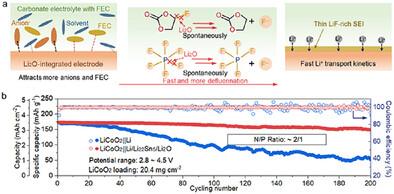集成li20电极增强高性能锂金属电池富liff界面的吸附/除氟动力学
IF 19
1区 材料科学
Q1 CHEMISTRY, MULTIDISCIPLINARY
引用次数: 0
摘要
锂(Li)阳极的界面化学调节对于构建坚固的固-电解质界面相(SEI)和实现可靠的锂金属电池(lmb)至关重要。本文提出了一种基于电极的策略,通过将机械化学生成的Li2O纳米颗粒加入Li/Li22Sn5复合电极中,从而构建富liff SEI,来调节氟化电解质物种的吸附/除氟动力学。这种方法与依赖于浓缩盐或复杂电解质配方的传统方法有根本区别。光谱表征结合密度泛函理论模拟证实了集成li2o纳米颗粒对FEC和PF6 -阴离子的强吸附,促进了它们的自发脱氟,促进了SEI内LiF的优先形成。这种富含无机的界面相使Li沉积均匀,即使在60°C下也能减轻电解质腐蚀。因此,复合电极在1 mA cm - 2和1 mAh cm - 2的碳酸盐电解质中,在50次电镀/剥离循环中提供了99.0%的高平均库仑效率。与LiCoO2阴极配对,在低正负比为2:1的情况下,该材料具有出色的循环性能,在稀电解质条件下(20µL),在2.8-4.5 V宽电压范围内循环200次后,其容量保持率为87.0%,容量保持率为84.8%。这项工作强调了调节吸附/除氟动力学是设计富liff SEI和实现高性能lmb的有效途径。本文章由计算机程序翻译,如有差异,请以英文原文为准。

Li2O-Integrated Electrodes Enabling Enhanced Adsorption/Defluorination Kinetics Toward LiF-Rich Interphase for High-Performance Lithium Metal Batteries
Regulating interfacial chemistry at lithium (Li) anodes is vital for constructing robust solid-electrolyte interphase (SEI) and achieving reliable Li metal batteries (LMBs). Herein, an electrode-based strategy is proposed to regulate adsorption/defluorination kinetics of fluorinated electrolyte species by incorporating mechanochemically generated Li2O nanoparticles into the Li/Li22Sn5 composite electrode, thereby constructing a LiF-rich SEI. This approach fundamentally differs from conventional methods that rely on concentrated salts or complex electrolyte formulations. Spectroscopic characterizations combined with density functional theory simulations confirm that the integrated-Li2O nanoparticles strongly adsorb FEC and PF6– anions and promote their spontaneous defluorination, facilitating the preferential formation of LiF within the SEI. This inorganic-rich interphase homogenizes Li deposition and mitigates electrolyte corrosion even at 60 °C. Consequently, the composite electrode delivers a high average Coulombic efficiency of 99.0% over 50 plating/stripping cycles in carbonate electrolyte at 1 mA cm−2 and 1 mAh cm−2. Paired with LiCoO2 cathodes, it achieves outstanding cyclability with 87.0% capacity-retention at a low negative-to-positive ratio of 2:1 and 84.8% capacity-retention under lean-electrolyte conditions (20 µL) after 200 cycles over a wide voltage range of 2.8–4.5 V. This work highlights regulating adsorption/defluorination kinetics as an effective route to engineer LiF-rich SEI and enable high-performance LMBs.
求助全文
通过发布文献求助,成功后即可免费获取论文全文。
去求助
来源期刊

Advanced Functional Materials
工程技术-材料科学:综合
CiteScore
29.50
自引率
4.20%
发文量
2086
审稿时长
2.1 months
期刊介绍:
Firmly established as a top-tier materials science journal, Advanced Functional Materials reports breakthrough research in all aspects of materials science, including nanotechnology, chemistry, physics, and biology every week.
Advanced Functional Materials is known for its rapid and fair peer review, quality content, and high impact, making it the first choice of the international materials science community.
 求助内容:
求助内容: 应助结果提醒方式:
应助结果提醒方式:


